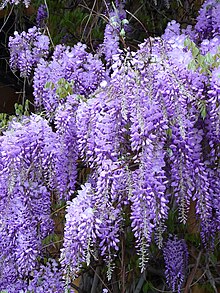紫藤屬
紫藤屬(學名:Wisteria),豆科蝶形花亞科下的一屬。紫藤屬下有數十種[1],皆屬攀緣植物,原產於東亞與北美洲。本屬許多種類是受歡迎的園藝植物,部分物種引進北美洲後成為當地的入侵物種。全株都可能有毒性,尤以種子毒性最高。東西方的許多藝術作品中均有出現紫藤的元素。
| 紫藤屬 | |
|---|---|

| |
| 中國紫藤的花 | |
| 科學分類 | |
| 界: | 植物界 Plantae |
| 演化支: | 維管束植物 Tracheophyta |
| 演化支: | 被子植物 Angiosperms |
| 演化支: | 真雙子葉植物 Eudicots |
| 演化支: | 薔薇類植物 Rosids |
| 目: | 豆目 Fabales |
| 科: | 豆科 Fabaceae |
| 亞科: | 蝶形花亞科 Faboideae |
| 族: | 崖豆藤族 Millettieae |
| 屬: | 紫藤屬 Wisteria Nutt. |
| 物種 | |
| |
| 異名 | |
| |
命名
編輯發表、命名紫藤屬的植物學家托馬斯·納托爾表示屬名Wisteria是紀念著名醫師卡斯帕·威斯塔對科學的貢獻而取[2][3],當有人對Wistar與Wister字尾拼寫不同提出疑問時,納托爾回答是為了讓聲調聽起來更和諧,不過其傳記的作者懷疑這個學名有可能與托馬斯的好友Charles Jones Wister, Sr有關[4]。因為此拼寫錯誤顯然是納托爾有意為之,根據國際藻類、真菌、植物命名法規,此名也沒有改為Wistaria的必要[5],不過仍有人將其拼寫成Wistaria,例如當代英文用法詞典便採取此用法[6][7]。
外觀與生理
編輯紫藤屬植物的生長方式是將其莖順時針或逆時針地環繞任何可提供支持的結構,本屬最常見的兩物種中,日本紫藤的纏繞方式由上往下看是順時針,中國紫藤則是逆時針,這種差別有助於分辨這兩種物種[9]。紫藤屬植物可攀爬高達20公尺,並向側面延展10公尺。世界上最大株的紫藤屬植物是一株1894年栽種、位於美國加州馬德雷的中國紫藤,全株延伸的面積超過一英畝[10]。紫藤屬植物的葉呈互生,長15-35公分,羽狀複葉上有9-19片小葉。其花長於長10-80公分、下垂的總狀花序上,形似毒豆屬植物的花,但毒豆屬的花是黃色,紫藤屬的花則是紫色、粉紅色或白色。
另外,紫藤屬全株都含有一種稱為紫藤素(Wisterin)的皂素,尤以豆莢中的種子含量最多,如果食用可能造成頭暈、噁心、困惑、言語障礙、嘔吐、胃痛、腹瀉甚至昏厥[11][12]。紫藤屬植物的種子已造成多起小孩或寵物食用後中毒的案例,但種子之外的部位紫藤素濃度是否足以造成中毒仍有爭議[12][13][14]。除了紫藤素外,紫藤屬植物的種子還含有刀豆胺酸,對人也有毒性。除了避免草食動物食用外,刀豆胺酸萌發時也能為成長中的胚胎提供氮源[15],這兩種毒素造成紫藤屬種子的毒性甚高,食用一至兩顆種子即可能導致中毒[15]。
紫藤屬植物生長速度很快,且可以在營養較少的土壤中生長。紫藤屬與許多豆科植物一樣可以與根瘤菌共生固氮,加入過多氮肥可能會抑制其開花[16]
分布
編輯紫藤與多花紫藤原產於中國大陸[17],1816年與1830年分別作為園藝植物從中國與日本引入美國[18],因生長迅速而在美國許多地方(特別是西南部)成了入侵物種[18]。
美洲紫藤則原產於美國東部,分佈範圍南至德克薩斯州、佛羅里達州,北至伊利諾州,東至維吉尼亞州[19],其侵略性比來自亞洲的紫藤弱[20]。
蘇州博物館太平天國忠王府東南角臥虬堂南外側有一株紫藤,據傳爲明代書畫家文徵明親手種植,被尊稱爲「文藤」。旁有端方題刻「文衡山先生手植藤」石碑。
演化與分類
編輯根據葉綠體DNA分析,紫藤屬、昆明雞血藤屬與泰豆屬三者的親緣關係相當接近,與同屬崖豆藤族的其他物種有明顯差異。這三個屬的物種基因組都是由8條染色體組成[21][22]。
種
編輯- 山紫藤 Wisteria brachybotrys
- 短梗紫藤 Wisteria brevidentata
- 多花紫藤 Wisteria floribunda
- 美洲紫藤 Wisteria frutescens
- 紫藤 Wisteria sinensis
- 白花紫藤:紫藤的一個變種
- 白花藤蘿 Wisteria venusta
- 藤蘿 Wisteria villosa
-
多花紫藤
-
美洲紫藤
-
紫藤
-
白花藤蘿
-
山紫藤
藝術
編輯東西方藝術中都可見紫藤的元素。日本許多公家與武家的家紋中有紫藤的圖案[24],另外著名歌舞伎劇目《藤娘》中的主角即為具有女人形象的紫藤精靈;西方藝術中,紫藤的圖案有時出現在建築的瓷磚或玻璃彩繪裡[25]。
參考文獻
編輯- ^ Wisteria Nutt.. Tropicos. [2018-07-14]. (原始內容存檔於2019-06-10).
- ^ Nuttall, Thomas. The Genera of North American Plants and a Catalogue of the Species, to the Year 1817 I. D. Heartt. 1818: 115 [2011-05-15]. (原始內容存檔於2020-06-18).
- ^ Ohio State University, Wisteria (頁面存檔備份,存於網際網路檔案館). Accessed 2009.06.02.
- ^ Graustein, Jeannette E. Thomas Nuttall, Naturalist: Explorations in America, 1808–1841. Harvard University Press. 1967: 123.
- ^ Charters, Michael L. Page W. California Plant Names: Latin and Greek Meanings and Derivations. [2011-05-15]. (原始內容存檔於2018-09-29).
- ^ Bryson, Bill. Ch. 6 — Science Red in Tooth and Claw. A Short History of Nearly Everything 1st. New York, NY: Broadway Books. 2003. ISBN 0-375-43200-0.
- ^ Dixon, Richard; Howard, Philip. Wisteria? Wistaria? Let's call the whole thing off. The Times (London). June 5, 2009 [2011-05-16]. (原始內容存檔於May 29, 2010).
- ^ Hygrophila difformis. Natural Aquariums. [2018-07-14]. (原始內容存檔於2021-04-18).
- ^ Peter., Valder,. Wisterias : a comprehensive guide. Portland, Or.: Timber Press. 1995. ISBN 0881923184. OCLC 32647814.
- ^ Sierra Madre Wistaria Festival 2015. Sierra Madre News Net. [2018-07-14]. (原始內容存檔於2021-01-25).
- ^ Lewis, Robert Alan. Lewis' Dictionary of Toxicology. CRC Press. 1998-03-23. ISBN 9781566702232 (英語).
- ^ 12.0 12.1 Rondeau, E. S. Wisteria toxicity. Journal of Toxicology. Clinical Toxicology. 1993-01-01, 31 (1): 107–112. ISSN 0731-3810. PMID 8433406. doi:10.3109/15563659309000378.
- ^ Mcdonald, Gregory E. Wisteria sinensis.. University of Florida IFAS. University of Florida. [12 August 2017]. (原始內容存檔於2017-08-12).
- ^ Canadian Poisonous Plants Information System - Wisteria floribunda (Scientific name). Agriculture and Agri-Food Canada. Government of Canada. [2016-02-22]. (原始內容存檔於2020-03-10).
- ^ Meghan Ray. Pruning and Training Wisteria. Fine Gardening. [2018-07-14]. (原始內容存檔於2021-01-19).
- ^ 紫藤属 Wisteria Nutt.. 第40卷 豆科. 中國植物志. [2018-07-14]. (原始內容存檔於2018-12-07).
- ^ 18.0 18.1 Wisteria floribunda, W. sinensis. United States Forest Service (USFS). [2016-02-22]. (原始內容存檔於2021-01-26).
- ^ Wisteria frutescens. 密蘇里植物園. [2018-07-14]. (原始內容存檔於2021-01-26).
- ^ Wisteria frutescens. Lady Bird Johnson Wildflower Center. [2018-07-14]. (原始內容存檔於2021-04-10).
- ^ Hu, Jer-Ming; Lavin, Matt; Wojciechowski, Martin F.; Sanderson, Michael J. Phylogenetic systematics of the tribe Millettieae (Leguminosae) based on chloroplast trnK/matK sequences and its implications for evolutionary patterns in Papilionoideae. American Journal of Botany. 2000, 87 (3): 418–30. PMID 10719003. doi:10.2307/2656638.
- ^ Li, Jianhua; Jiang; Fu; Tang. Molecular systematics and biogeography of Wisteria inferred from nucleotide sequences of nuclear and plastid genes. Journal of Systematics and Evolution. 2014, 52 (1): 40–50. doi:10.1111/jse.12061.
- ^ Jarantoski, K.S. Wisteria frutescens and W. macrostachya. The Public garden: journal of the American Association of Botanical Gardens and Arboreta. January 1988, 3 (1): 33.
- ^ Baird, Merrily C. Symbols of Japan: Thematic Motifs in Art and Design. New York: Random House, Inc. 2001: 67. OCLC 237418692.
- ^ Notices of New Books. The New Englander. Vol. XLIV. 1885: 304 [2021-04-14]. (原始內容存檔於2021-04-16).
The Art Amateur for February contains the usual profusion of designs for art work, including decorations for a dessert-plate (asters), a double tile (wisteria)...